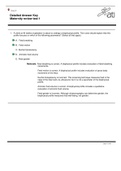Exam (elaborations)
ATI Maternity - Detailed practice Answer Key Updated for 2024
- Course
- ATI Testing
- Institution
- Chamberlain College Of Nursing
ATI Maternity - Detailed practice Answer Key Updated for 2024ATI Maternity - Detailed practice Answer Key Updated for 2024ATI Maternity - Detailed practice Answer Key Updated for 2024ATI Maternity - Detailed practice Answer Key Updated for 2024ATI Maternity - Detailed practice Answer Key Updated fo...
[Show more]



